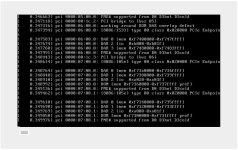The screenshot you posted is from PCI(e) initialization. There should be a lot of output before that.
So no, I doubt, that the kernel crashes "that fast". "0.34 seconds" (according to your screenshot) might sound early, but in terms of kernel boot, there is a lot going on before that.
Alright, Fingers crossed

.
Do you still have the "quiet" commandline parameter somewhere in your Linux kernel commandline for the bootloader?
If yes, get rid of it. Otherwise you can also add "loglevel=7" for maximum output verbosity.
I think I added a
debug Parameter too (also used to debug Initramfs), but it might well be that there is
quiet Parameter that I missed. Thanks for the Tip. Let me check that

.
Oh and make sure to edit the right files. Some setups use systemd-boot (/etc/kernel/cmdline), while others use grub2 (/etc/default(grub). Double-check that in any case!
That's surely NOT an Issue in my Case

. It's always GRUB2. For how "bad" everybody considers it compared to Systemd or ZFSBootMenu especially with ZFS (and I had to go back to /boot on a
mdadm RAID-1 Mirror of EXT4 Partition because it would NOT work, even with compatibility Mode set, when ZFS Snapshots got created), I am using that pretty much everywhere (minus the ARM Single Board Computers).
And BTW, is there a specific reason, that you limited your trials to upto "ttyS2"? It might be, that the kernel still sees the chipset UARTs (depending on how Supermicro set up the BIOS) and lists the Aspeed ones only above that. So maybe even higher numbers.
My logic was that since COM1 & COM2 are the Physical Ports, I was thinking that they would be the First ones (plus maybe one "spare" or ttyS0 was reserved by something else on the ASPEED BMC).
Is there any Way to find out which one it's really active ?
I couldn't get it to work at all even in a Booted Environment though (when I boot Kernel 5.15.131 I did try to send some Serial Messages from one PC to the other, but unfortunately it didn't work).
Furthermore I remember I once had to Troublshoot a Network Switch using DB9 Serial, and I'm pretty sure I was using
/dev/ttyS0 or
/dev/ttyS1 in that Case (different Situation, the System was already booted up and the Supermicro PC was NOT trying to send Debug Information via a Null-Modem Cable like I am trying here).
Otherwise I should probably order a few USB Adapters. I have plenty of CH340/CH341/CP2102 and Similar Adapters (mostly bought to troubleshoot Microcontrollers, some to flash some BIOS Chips via SPI), but they are almost all breakout Type OR it's NOT an USB Connection

.

 .
. .
.

